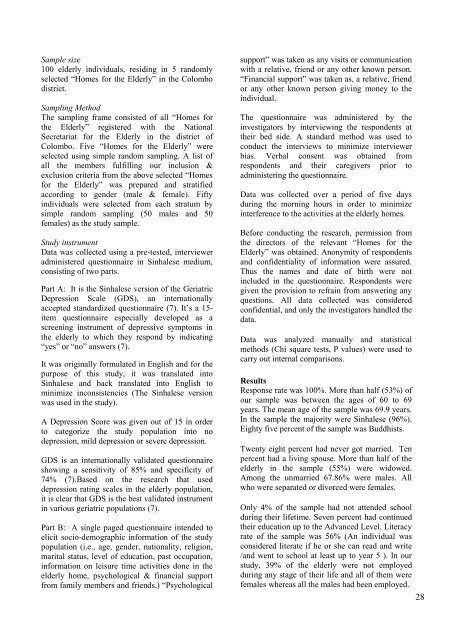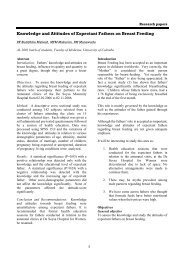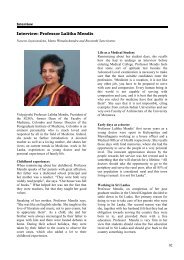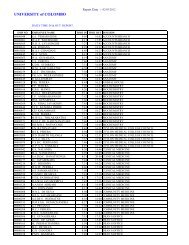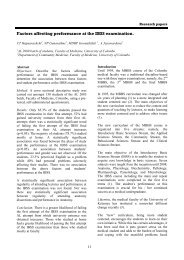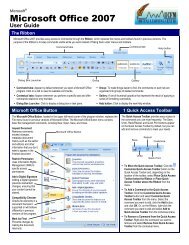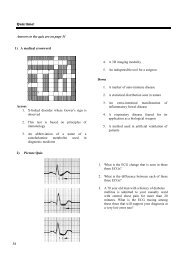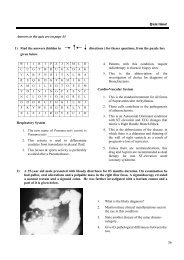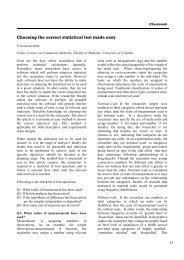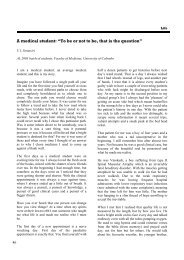Prevalence of depression among institutionalized elders in the ...
Prevalence of depression among institutionalized elders in the ...
Prevalence of depression among institutionalized elders in the ...
Create successful ePaper yourself
Turn your PDF publications into a flip-book with our unique Google optimized e-Paper software.
Sample size<br />
100 elderly <strong>in</strong>dividuals, resid<strong>in</strong>g <strong>in</strong> 5 randomly<br />
selected “Homes for <strong>the</strong> Elderly” <strong>in</strong> <strong>the</strong> Colombo<br />
district.<br />
Sampl<strong>in</strong>g Method<br />
The sampl<strong>in</strong>g frame consisted <strong>of</strong> all “Homes for<br />
<strong>the</strong> Elderly” registered with <strong>the</strong> National<br />
Secretariat for <strong>the</strong> Elderly <strong>in</strong> <strong>the</strong> district <strong>of</strong><br />
Colombo. Five “Homes for <strong>the</strong> Elderly” were<br />
selected us<strong>in</strong>g simple random sampl<strong>in</strong>g. A list <strong>of</strong><br />
all <strong>the</strong> members fulfill<strong>in</strong>g our <strong>in</strong>clusion &<br />
exclusion criteria from <strong>the</strong> above selected “Homes<br />
for <strong>the</strong> Elderly” was prepared and stratified<br />
accord<strong>in</strong>g to gender (male & female). Fifty<br />
<strong>in</strong>dividuals were selected from each stratum by<br />
simple random sampl<strong>in</strong>g (50 males and 50<br />
females) as <strong>the</strong> study sample.<br />
Study <strong>in</strong>strument<br />
Data was collected us<strong>in</strong>g a pre-tested, <strong>in</strong>terviewer<br />
adm<strong>in</strong>istered questionnaire <strong>in</strong> S<strong>in</strong>halese medium,<br />
consist<strong>in</strong>g <strong>of</strong> two parts.<br />
Part A: It is <strong>the</strong> S<strong>in</strong>halese version <strong>of</strong> <strong>the</strong> Geriatric<br />
Depression Scale (GDS), an <strong>in</strong>ternationally<br />
accepted standardized questionnaire (7). It’s a 15-<br />
item questionnaire especially developed as a<br />
screen<strong>in</strong>g <strong>in</strong>strument <strong>of</strong> depressive symptoms <strong>in</strong><br />
<strong>the</strong> elderly to which <strong>the</strong>y respond by <strong>in</strong>dicat<strong>in</strong>g<br />
“yes” or “no” answers (7).<br />
It was orig<strong>in</strong>ally formulated <strong>in</strong> English and for <strong>the</strong><br />
purpose <strong>of</strong> this study, it was translated <strong>in</strong>to<br />
S<strong>in</strong>halese and back translated <strong>in</strong>to English to<br />
m<strong>in</strong>imize <strong>in</strong>consistencies (The S<strong>in</strong>halese version<br />
was used <strong>in</strong> <strong>the</strong> study).<br />
A Depression Score was given out <strong>of</strong> 15 <strong>in</strong> order<br />
to categorize <strong>the</strong> study population <strong>in</strong>to no<br />
<strong>depression</strong>, mild <strong>depression</strong> or severe <strong>depression</strong>.<br />
GDS is an <strong>in</strong>ternationally validated questionnaire<br />
show<strong>in</strong>g a sensitivity <strong>of</strong> 85% and specificity <strong>of</strong><br />
74% (7).Based on <strong>the</strong> research that used<br />
<strong>depression</strong> rat<strong>in</strong>g scales <strong>in</strong> <strong>the</strong> elderly population,<br />
it is clear that GDS is <strong>the</strong> best validated <strong>in</strong>strument<br />
<strong>in</strong> various geriatric populations (7).<br />
Part B: A s<strong>in</strong>gle paged questionnaire <strong>in</strong>tended to<br />
elicit socio-demographic <strong>in</strong>formation <strong>of</strong> <strong>the</strong> study<br />
population (i.e., age, gender, nationality, religion,<br />
marital status, level <strong>of</strong> education, past occupation,<br />
<strong>in</strong>formation on leisure time activities done <strong>in</strong> <strong>the</strong><br />
elderly home, psychological & f<strong>in</strong>ancial support<br />
from family members and friends.) “Psychological<br />
support” was taken as any visits or communication<br />
with a relative, friend or any o<strong>the</strong>r known person.<br />
“F<strong>in</strong>ancial support” was taken as, a relative, friend<br />
or any o<strong>the</strong>r known person giv<strong>in</strong>g money to <strong>the</strong><br />
<strong>in</strong>dividual.<br />
The questionnaire was adm<strong>in</strong>istered by <strong>the</strong><br />
<strong>in</strong>vestigators by <strong>in</strong>terview<strong>in</strong>g <strong>the</strong> respondents at<br />
<strong>the</strong>ir bed side. A standard method was used to<br />
conduct <strong>the</strong> <strong>in</strong>terviews to m<strong>in</strong>imize <strong>in</strong>terviewer<br />
bias. Verbal consent was obta<strong>in</strong>ed from<br />
respondents and <strong>the</strong>ir caregivers prior to<br />
adm<strong>in</strong>ister<strong>in</strong>g <strong>the</strong> questionnaire.<br />
Data was collected over a period <strong>of</strong> five days<br />
dur<strong>in</strong>g <strong>the</strong> morn<strong>in</strong>g hours <strong>in</strong> order to m<strong>in</strong>imize<br />
<strong>in</strong>terference to <strong>the</strong> activities at <strong>the</strong> elderly homes.<br />
Before conduct<strong>in</strong>g <strong>the</strong> research, permission from<br />
<strong>the</strong> directors <strong>of</strong> <strong>the</strong> relevant “Homes for <strong>the</strong><br />
Elderly” was obta<strong>in</strong>ed. Anonymity <strong>of</strong> respondents<br />
and confidentiality <strong>of</strong> <strong>in</strong>formation were assured.<br />
Thus <strong>the</strong> names and date <strong>of</strong> birth were not<br />
<strong>in</strong>cluded <strong>in</strong> <strong>the</strong> questionnaire. Respondents were<br />
given <strong>the</strong> provision to refra<strong>in</strong> from answer<strong>in</strong>g any<br />
questions. All data collected was considered<br />
confidential, and only <strong>the</strong> <strong>in</strong>vestigators handled <strong>the</strong><br />
data.<br />
Data was analyzed manually and statistical<br />
methods (Chi square tests, P values) were used to<br />
carry out <strong>in</strong>ternal comparisons.<br />
Results<br />
Response rate was 100%. More than half (53%) <strong>of</strong><br />
our sample was between <strong>the</strong> ages <strong>of</strong> 60 to 69<br />
years. The mean age <strong>of</strong> <strong>the</strong> sample was 69.9 years.<br />
In <strong>the</strong> sample <strong>the</strong> majority were S<strong>in</strong>halese (96%).<br />
Eighty five percent <strong>of</strong> <strong>the</strong> sample was Buddhists.<br />
Twenty eight percent had never got married. Ten<br />
percent had a liv<strong>in</strong>g spouse. More than half <strong>of</strong> <strong>the</strong><br />
elderly <strong>in</strong> <strong>the</strong> sample (55%) were widowed.<br />
Among <strong>the</strong> unmarried 67.86% were males. All<br />
who were separated or divorced were females.<br />
Only 4% <strong>of</strong> <strong>the</strong> sample had not attended school<br />
dur<strong>in</strong>g <strong>the</strong>ir lifetime. Seven percent had cont<strong>in</strong>ued<br />
<strong>the</strong>ir education up to <strong>the</strong> Advanced Level. Literacy<br />
rate <strong>of</strong> <strong>the</strong> sample was 56% (An <strong>in</strong>dividual was<br />
considered literate if he or she can read and write<br />
/and went to school at least up to year 5 ). In our<br />
study, 39% <strong>of</strong> <strong>the</strong> elderly were not employed<br />
dur<strong>in</strong>g any stage <strong>of</strong> <strong>the</strong>ir life and all <strong>of</strong> <strong>the</strong>m were<br />
females whereas all <strong>the</strong> males had been employed.<br />
28


